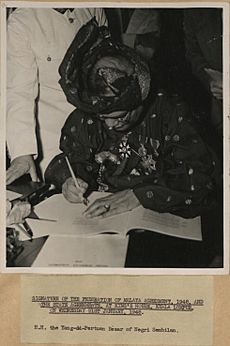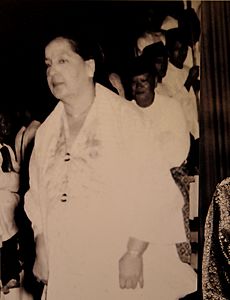Abdul Rahman of Negeri Sembilan facts for kids
Quick facts for kids Abdul Rahmanعبدالرحمن |
|||||||||
|---|---|---|---|---|---|---|---|---|---|
| Yang di-Pertuan Agong I | |||||||||

Abdul c. 1950s
|
|||||||||
| Yang di-Pertuan Agong | |||||||||
| Reign | 31 August 1957 – 1 April 1960 | ||||||||
| Installation | 2 September 1957 | ||||||||
| Predecessor | Position established Elizabeth II (As Queen) |
||||||||
| Successor | Hisamuddin of Selangor | ||||||||
| Prime Minister | Tunku Abdul Rahman | ||||||||
| Yang di-Pertuan Besar of Negeri Sembilan | |||||||||
| Reign | 3 August 1933 – 1 April 1960 | ||||||||
| Installation | 25 April 1934 | ||||||||
| Predecessor | Muhammad | ||||||||
| Successor | Munawir | ||||||||
| Born | 24 August 1895 Istana Lama Seri Menanti, Seri Menanti, Negeri Sembilan, Federated Malay States, British Malaya |
||||||||
| Died | 1 April 1960 (aged 64) Istana Negara, Kuala Lumpur, Malaya |
||||||||
| Burial | 5 April 1960 Seri Menanti Royal Mausoleum, Seri Menanti, Negeri Sembilan, Malaya |
||||||||
| Spouse | Cik Engku Maimunah binti Abdullah (Dulcie Campbell) Tunku Maharun binti Tengku Mambang Tunku Kurshiah binti Tunku Besar Burhanuddin
(m. 1929–1960)Tunku Zaidah binti Tunku Zakaria |
||||||||
| Issue Detail |
Tunku Ja'afar Tunku Abdullah Tunku Aida Tunku Sheilah Tunku Munawir Tunku Bahiyah Tunku Shahariah Tunku Noraida Zakia |
||||||||
|
|||||||||
| House | Pagaruyung (House of Yamtuan Raden) | ||||||||
| Father | Tuanku Muhammad ibni Almarhum Tuanku Antah | ||||||||
| Mother | Tunku Halija binti Tunku Muda Chik | ||||||||
| Religion | Sunni Islam | ||||||||
Tuanku Sir Abdul Rahman ibni Almarhum Tuanku Muhammad (born August 24, 1895 – died April 1, 1960) was a very important leader in Malayan history. He was the first ever Yang di-Pertuan Agong, which means the Supreme Head or King, of independent Malaya. He was also the eighth Yang di-Pertuan Besar (Ruler) of Seri Menanti and the second Ruler of modern Negeri Sembilan.
Contents
The Early Life of Tuanku Abdul Rahman
Tuanku Abdul Rahman was born in Seri Menanti on August 24, 1895. He was the second son of Tuanku Muhammad, who was the first Ruler of modern Negeri Sembilan. His mother was Tunku Puan Chik.
His Education and First Jobs
He went to Jempol Malay School for his primary education. Later, from 1907 to 1914, he studied at the Malay College. After finishing school, he worked for a year at the Federal Secretariat in Kuala Lumpur. Then, he became an Assistant Collector of Land Revenue in Seremban.
He also joined the Malayan Volunteer Infantry. He started as a Second Lieutenant and was promoted to Lieutenant in 1918.
Preparing for Leadership
In 1917, his older brother, Tunku Abdul Aziz, passed away. After this, Tuanku Abdul Rahman was prepared to become the next ruler. He was given the title of Tunku Muda Serting.
He continued to work in different government roles. He was an Assistant Malay Officer in Klang and Sepang. He also worked in Ulu Selangor as an Assistant Collector of Land Revenue. Because he worked hard, he was promoted to Assistant District Officer. A big moment in his career was in 1925 when he worked briefly at the Kuala Lumpur Supreme Court.
Studying Law in the United Kingdom
In 1925, he went with his father, the Ruler of Negeri Sembilan, to the United Kingdom. They visited the British Empire Exhibition in Wembley and met King George V. During this trip, Tuanku Abdul Rahman decided he wanted to study law.
With his father's permission, he stayed in the UK to complete his law degree. He then qualified as a lawyer from Inner Temple. In 1928, he officially became a barrister. While in London, he was chosen as the first President of the Kesatuan Melayu United Kingdom. This was one of the first groups that promoted Malay nationalism.
When he returned to Malaya in December 1928, he worked in the Malayan Civil Service. He worked hard and became a Magistrate. Later, he was appointed as a District Officer.
Becoming the Ruler of Negeri Sembilan
In 1933, his father passed away, and Tuanku Abdul Rahman became the new Ruler of Negeri Sembilan. He was already a qualified lawyer, making him the only Malay ruler at that time with such legal qualifications.
During the Japanese occupation of Malaya (1942–1945), Tuanku Abdul Rahman was forced to make speeches that seemed to support the Japanese. However, he did this under pressure, and the Japanese also took away some of his royal rights.
Later, he signed the Malayan Union treaty, but he soon changed his mind. He then hired a lawyer in London to argue against the Malayan Union plan on behalf of the Malay rulers.
Becoming the First King of Malaya
On August 31, 1957, Malaya became an independent country. Tuanku Abdul Rahman was chosen as the first Yang di-Pertuan Agong, or Paramount Ruler. He was elected for a five-year term. He had been the ruler of Negeri Sembilan for 24 years before this important election.
His Installation as King
Tuanku Abdul Rahman was officially installed as the first Yang di-Pertuan Agong on September 2, 1957. The ceremony took place at the throne room of the Istana Negara in Kuala Lumpur.
Malay rulers do not traditionally wear crowns. Instead, he was installed by kissing the royal kris (a special dagger) of the state. This was done to the sound of the nobat, which is traditional royal music. Every Yang di-Pertuan Agong since then has followed this tradition.
To honor Tuanku Abdul Rahman, all future Kings of Malaysia have worn a special headdress called the Dendam Tak Sudah. This style comes from Negeri Sembilan.
His Passing and Funeral
Tuanku Abdul Rahman passed away peacefully in his sleep on April 1, 1960, at the Istana Negara in Kuala Lumpur. His body was laid in state at the Banquet Hall of the Istana Negara.
On April 2, 1960, a state funeral procession was held in Kuala Lumpur. His coffin was then taken by train to Seremban and by hearse to the Istana Besar, Seri Menanti. He was buried at the Royal Mausoleum in Seri Menanti, Negeri Sembilan, on April 5, 1960.
His Lasting Impact
Tuanku Abdul Rahman's face is still shown on the front of Malaysian Ringgit banknotes. This has been the case since the first series of banknotes was issued in 1967.
Sekolah Tuanku Abdul Rahman (Tuanku Abdul Rahman School), also known as STAR, is a famous all-boys boarding school in Malaysia. It is named after him and was built in 1957 in Ipoh, Perak.
His Belief in Democracy
Tuanku Abdul Rahman strongly believed in parliamentary democracy. This means that the people elect their leaders. One famous story shows this belief. In 1959, a foreign visitor complained to the King about Prime Minister Tunku Abdul Rahman Putra Al-Haj. The visitor wanted the King to remove the Prime Minister from his position.
The King replied, "I cannot remove him. He was elected by the people. As the Prime Minister of the country, he can even remove me!" This shows his strong belief in the power of the people and the democratic system.
His Family Life
Tuanku Abdul Rahman was married four times. His wives were:
- Cik Maimunah binti Abdullah (Dulcie Campbell), a nurse who became Muslim.
- Tunku Maharun binti Tunku Mambang, from the Negeri Sembilan royal family.
- Tunku Kurshiah binti Tunku Besar Burhanuddin, his cousin, who became the first Queen of Malaya.
- Tunku Zaidah binti Tunku Zakaria, another cousin.
He had three sons and five daughters. Two of his sons later became the Ruler of Negeri Sembilan:
- Tuanku Munawir (son of Tunku Maharun), who ruled from 1960 to 1967.
- Tuanku Ja'afar (son of Cik Engku Maimunah), who became ruler in 1967 and ruled until 2008. He also served as the tenth Yang di-Pertuan Agong of Malaysia from 1994 to 1999.
His grandson, Tuanku Muhriz, is currently the Ruler of Negeri Sembilan. His daughter, Sultanah Bahiyah, became the Queen of Kedah and also served as the fifth Queen of Malaysia from 1970 to 1975.
Hobbies and Interests
Tuanku Abdul Rahman enjoyed sports like cricket, football, and tennis. His favorite sport was boxing. When he was younger, he loved to put on boxing gloves and box with his sons.
Awards and Recognitions
Tuanku Abdul Rahman received many honors from Malaya and other countries.
National Honours
 Malaya:
Malaya:
- Recipient of the Order of the Crown of the Realm (DMN) (1958)
- Grand Commander of the Order of the Defender of the Realm (SMN)
Foreign Honours
 United Kingdom:
United Kingdom:
- Knight Commander of the Order of St Michael and St George (KCMG) - Sir (1934)
- Recipient of the King George V Silver Jubilee Medal (1935)
- Recipient of the King George VI Coronation Medal (1937)
- Recipient of the Queen Elizabeth II Coronation Medal (1953)
- Knight Grand Cross of the Order of St Michael and St George (GCMG) - Sir (1957)
 Brunei
Brunei
- Member First Class of the Family Order of Laila Utama (DK) - Dato Laila Utama (1959)
Places Named After Him
Many places are named after Tuanku Abdul Rahman to remember his contributions:
- Jalan Tuanku Abdul Rahman, a road in Kuala Lumpur
- Medan Tuanku district in downtown Kuala Lumpur
- Medan Tuanku Monorail station
- Sekolah Tuanku Abdul Rahman, a boys school in Ipoh, Perak
- Tuanku Abdul Rahman Mosque in Sarikei, Sarawak
- Tuanku Abdul Rahman Stadium in Paroi, Negeri Sembilan
- SK Tuanku Abdul Rahman, a primary school in Gemas, Negeri Sembilan
- SMK Tuanku Abdul Rahman, a secondary school in Gemas, Negeri Sembilan
- SMK Tuanku Abdul Rahman, a secondary school in Nibong Tebal, Penang
- SMK Tuanku Abdul Rahman, a secondary school in Rawang, Selangor
- Tuanku Abdul Rahman Residential College, a college at University of Malaya, Kuala Lumpur
Images for kids





